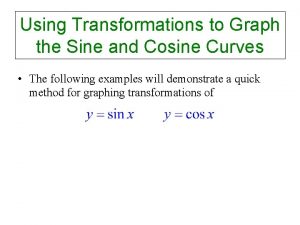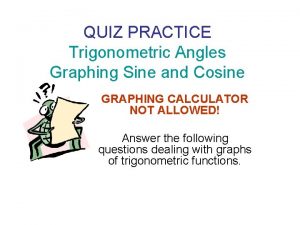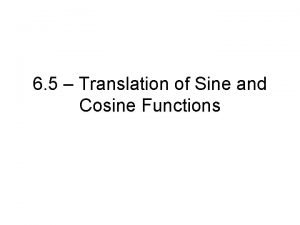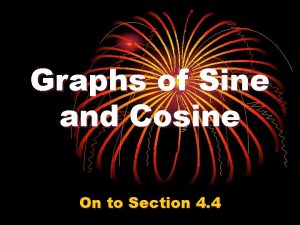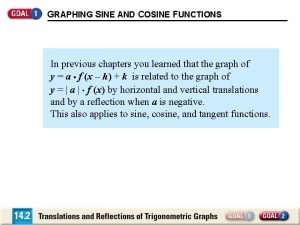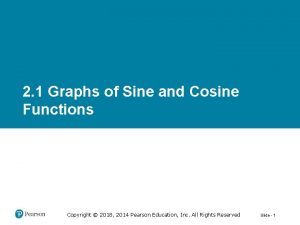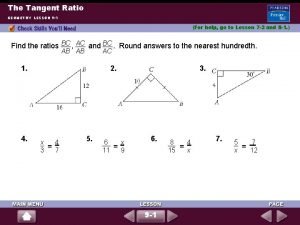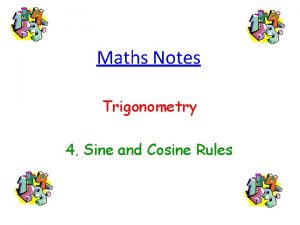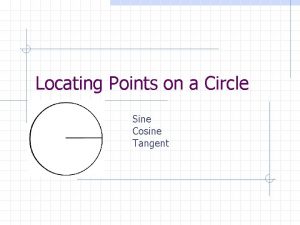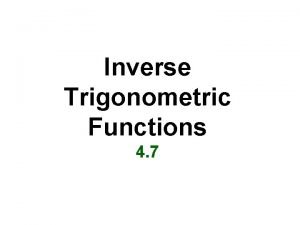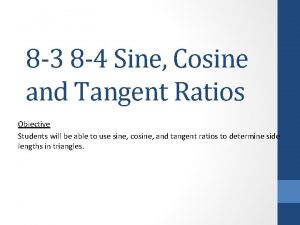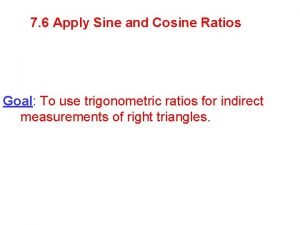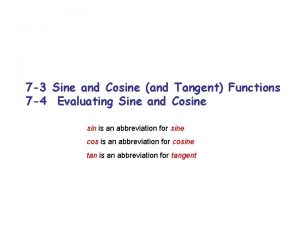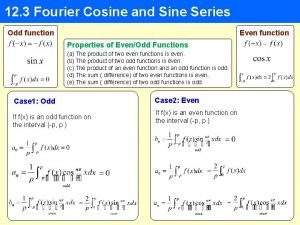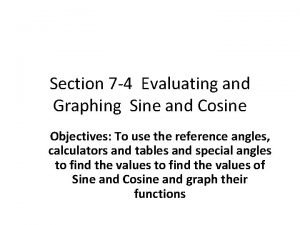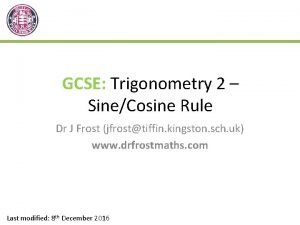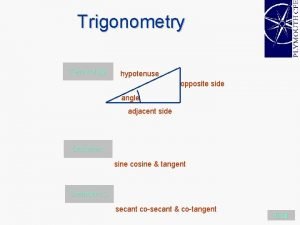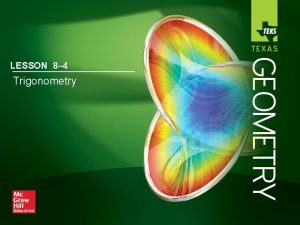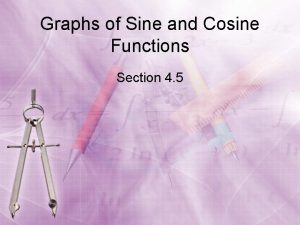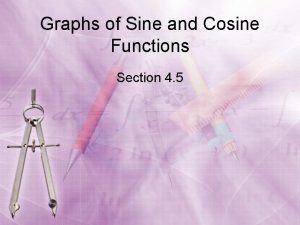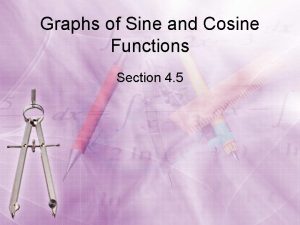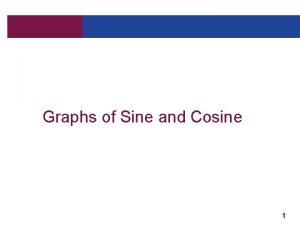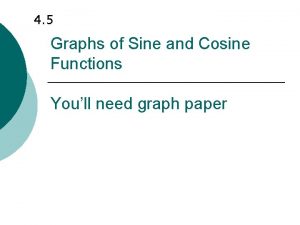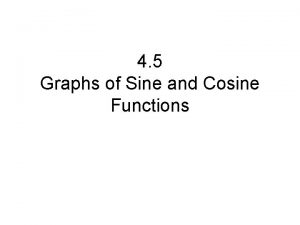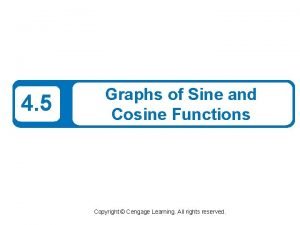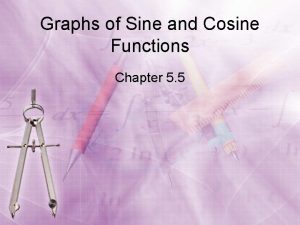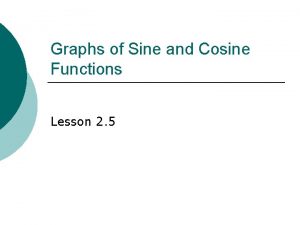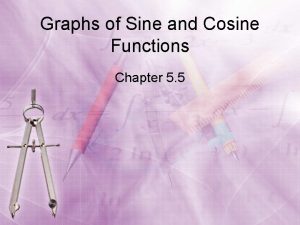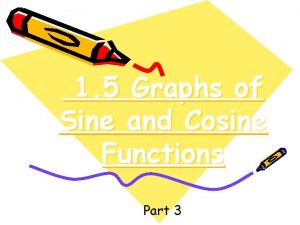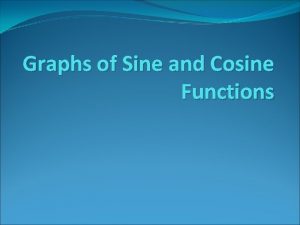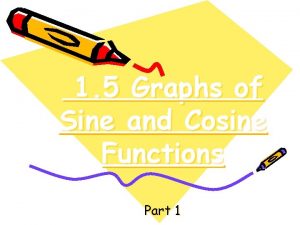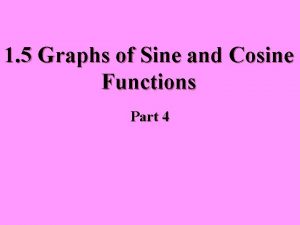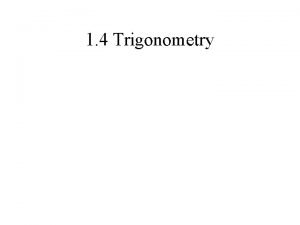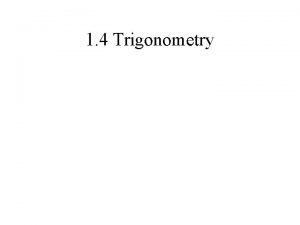SECTION 4 5 Graphs of Sine Cosine Functions
































- Slides: 32

SECTION 4. 5 Graphs of Sine & Cosine Functions MA. PC. 4. 5 2000 Define and graph trigonometric functions (i. e. , sine, cosine, tangent, cosecant, cotangent). MA. PC. 4. 6 2000 Find domain, range, intercepts, periods, amplitudes, and asymptotes of trigonometric functions. MA. PC. 4. 7 2000 Draw and analyze graphs of translations of trigonometric functions, including period, amplitude, and phase shift.

GRAPH OF Y = SIN X 1 π/ -1 2 π 3π/ 2 2π

Domain: all real numbers Range: -1<y<1

PERIODIC FUNCTION sin(t+2 )=sin t cos(t+2 )=cos t The sine and cosine functions are periodic functions and have period 2

GRAPH OF Y = COS X 1 π/ -1 2 π 3π/ 2 2π

Domain: all real numbers Range: -1<y<1

AMPLITUDES AND PERIODS Given the graph of y=Asin Bx Amplitude = |A| = distance up or down from center Period = 2 /B = time taken to repeat

Graphing y=½ sin x

Graphing y=-2 sin x

Graphing y=3 sin 2 x

EXAMPLE

EXAMPLE

THE GRAPH OF Y = A SIN(BX + C) The graph of y = A sin(Bx + C) is obtained by horizontally shifting the graph of y = A sin Bx so that the starting point of the cycle is shifted from x=0 to x=-C/B. This is called the phase shift. Amplitude = |A| Period = 2π/B

The Effect of Horizontally Shifting the Graph

EXAMPLE

EXAMPLE

Cosine with a Different Amplitude and Period

SINE AND COSINE FUNCTION y = A sin (Bx + C) + D or y = A cos (Bx + C) + D Amplitude = |A| How high above center it travels Period = 2π B How long it takes to complete a cycle (start over) Phase Shift = - C B where B > 0 If C > 0 the shift is to the left. If C < 0 the shift is to the right. Vertical Shift = D If D > 0, the shift is upward. If D < 0, the shift is downward. The midline (horizontal axis) is y = D.

HOMEWORK Page 533: 20 -56 every four Do NOT graph. Just identify the values.

SECTION 4. 5 Graphs of Sine & Cosine Functions MA. PC. 4. 5 2000 Define and graph trigonometric functions (i. e. , sine, cosine, tangent, cosecant, cotangent). MA. PC. 4. 6 2000 Find domain, range, intercepts, periods, amplitudes, and asymptotes of trigonometric functions. MA. PC. 4. 7 2000 Draw and analyze graphs of translations of trigonometric functions, including period, amplitude, and phase shift.

GRAPHING SINE AND COSINE FUNCTIONS Step 1 Determine the vertical shift and graph the midline with a dashed line. Step 2 Determine the amplitude. Use dashed lines to indicate the maximum and minimum values of the function. Step 3 Determine the period of the function and graph the appropriate sine or cosine curve. Step 4 Determine the phase shift and translate the graph accordingly.

GRAPHING State the amplitude, period, phase shift, and vertical shift for y = 4 cos (x/2 + π) – 6. Then graph the function. 1: Vertical shift = midline = D = (graph dotted midline) 4π 2: Amplitude = |A| = (dotted max and min lines) 3: Period = 2π/B = (dotted function) 4: Phase shift = -C/B = (graph translation)

GRAPHING State the amplitude, period, phase shift, and vertical shift for y = 2 cos (x/4 + π) – 1. Then graph the function.

MODELING PERIODIC BEHAVIOR

EXAMPLE The tides are very high in some areas of Canada. The depth of the water at a boat dock varies from a high tide of 20 feet to a low tide of 6 feet. On a certain day, high tide is at 2 am and low tide is at 8 am. Use a sine function to model the waters depth. 20 10 2 6 10 14 18 22 26 The number of hours after midnight.

Simple Harmonic Motion

SIMPLE HARMONIC MOTION

Frequency = 1 / Period




HOMEWORK Page 533: 58 -64 even, 85
 Sine and cosine graphs
Sine and cosine graphs Sine function transformations
Sine function transformations 9-5 practice graphing trigonometric functions
9-5 practice graphing trigonometric functions 4-4 practice graphing sine and cosine functions
4-4 practice graphing sine and cosine functions Sine function graph
Sine function graph 6-5 practice translations of sine and cosine functions
6-5 practice translations of sine and cosine functions Trig functions transformations
Trig functions transformations Graph of sine and cosine functions
Graph of sine and cosine functions Reflection of sine graph
Reflection of sine graph Sinusoidal graphs
Sinusoidal graphs Transformations of sine and cosine functions
Transformations of sine and cosine functions Polynomial end behavior chart
Polynomial end behavior chart Triangle trigonometry
Triangle trigonometry Practice 9-1 the tangent ratio answers
Practice 9-1 the tangent ratio answers Make cos c the subject of the formula
Make cos c the subject of the formula Sine and cosine law maze
Sine and cosine law maze Sohcahtoa practice
Sohcahtoa practice Cosine rule for side
Cosine rule for side Sine cosine tangent circle
Sine cosine tangent circle Inverse sine and cosine
Inverse sine and cosine Sine cosine rule
Sine cosine rule Sine word problems
Sine word problems Sine, cosine, and tangent
Sine, cosine, and tangent Burj khalifa trigonometry
Burj khalifa trigonometry Sin and cos in quadrants
Sin and cos in quadrants Site:slidetodoc.com
Site:slidetodoc.com Sine graph transformations
Sine graph transformations Trigonometric graph equation
Trigonometric graph equation Trigonometry dr frost
Trigonometry dr frost The sine and cosine curves intersect infinitely
The sine and cosine curves intersect infinitely Sin = adjacent or opposite
Sin = adjacent or opposite Opposite hypotenuse
Opposite hypotenuse 8-3 trigonometry
8-3 trigonometry
